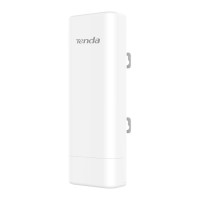Set up the maximum length of frames that can be transmitted without fragmentation.
The range is 256~2346 bytes.
Fragmentation means to fragment a large frame into small pieces, with each piece
transmitted and acknowledged separately. When the length of a frame exceeds the
specified fragment threshold value, it is fragmented.
A longer frame is less likely to be successfully received. Therefore, in a WLAN where
there is high error rate, you can decrease the fragment threshold to increase frame
transmission reliability.
In a WLAN network with no interference, we recommend that you increase the
Fragment Threshold to improve the data transmission throughput by decreasing the
ACK times.
Set up the threshold length for RTS/CTS mechanism.
RTS/CTS frames occupy a certain network bandwidth so that only the frames larger
than RTS/CTS threshold will enable RTS/CTS mechanism to avoid data sending collisions
in a WLAN network. The RTS/CTS threshold range is 1~2347 bytes.
You need to set up a rational value: A small value causes RTS packets to be sent more
often, thus consuming more of the available bandwidth. However, the more often RTS
packets are sent, the quicker the system can recover from interference or collisions. We
recommend that you set up a small value in a high-density WLAN network to decrease
the probability of collision.
Set up the number of beacon intervals between Delivery Traffic Indication Message
(DTIM) transmissions. The range is 1~255 Beacon interval.
The AP sends buffered broadcast/multicast frames with the configured DTIM interval.
For example, if you set DTIM to 2, the AP will send buffered broadcast/multicast frames
every two Beacon intervals.
WMM is a wireless QoS protocol designed to preferentially transmit packets with high
priority, thus guaranteeing better QoS services for voice and video applications in a
WLAN network.
APSD (Automatic Power Save Delivery) is disabled by default.
Mainly used for preamble synchronization. It is advisable to keep the default value
unchanged.
Define the minimum client signal level accepted by the AP for the client to connect to. If
the client signal level subsequently drops, the client remains connected to the AP.
LED Signal Threshold
(LED1/LED2/LED3)
When two devices bridge successfully, LED1/LED2/LED3 keeps solid. The three LEDs
indicate the signal strength of the other bridged device. By default, the relations
between the signal strength and LEDs are shown below, and you can modify each LED’s
threshold on the web UI.
-90 dBm < signal strength < -80dBm: LED1 turns green.
-80 dBm < signal strength < -70dBm: LED1 and LED2 turn green.
-70 dBm < signal strength: All the three LEDs turn green.

